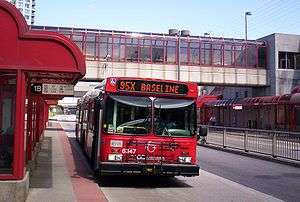Trillium Line
The Trillium Line (French: Ligne Trillium), also called O-Train Line 2 (French: Ligne 2 de l'O-Train),[3] is a diesel light rail transit (DLRT) service in Ottawa, Ontario, Canada, operated by OC Transpo. The line is part of the O-Train light rail system. On May 3, 2020, the Trillium Line was shut down for two years to accommodate the extension and upgrading of the line.[4][5] Replacement buses will serve each station during the construction period.[6]
| Trillium Line | |||||||||||||||||||||||||||||||||||||||||||||||||||||||||||||||||||||||||||||||||||||||||||||||||||||||||||||||||||||||||||||||||||||||||||||||||||||||||||||||||||||||||||||||||||||||||||||||||||||||||||||||||||||||||||||||||||||||||||||||||||||||||||||||||||||||||||||||||||||||||||||||||||||||||||||||||||||||||||||||||||||||||||
|---|---|---|---|---|---|---|---|---|---|---|---|---|---|---|---|---|---|---|---|---|---|---|---|---|---|---|---|---|---|---|---|---|---|---|---|---|---|---|---|---|---|---|---|---|---|---|---|---|---|---|---|---|---|---|---|---|---|---|---|---|---|---|---|---|---|---|---|---|---|---|---|---|---|---|---|---|---|---|---|---|---|---|---|---|---|---|---|---|---|---|---|---|---|---|---|---|---|---|---|---|---|---|---|---|---|---|---|---|---|---|---|---|---|---|---|---|---|---|---|---|---|---|---|---|---|---|---|---|---|---|---|---|---|---|---|---|---|---|---|---|---|---|---|---|---|---|---|---|---|---|---|---|---|---|---|---|---|---|---|---|---|---|---|---|---|---|---|---|---|---|---|---|---|---|---|---|---|---|---|---|---|---|---|---|---|---|---|---|---|---|---|---|---|---|---|---|---|---|---|---|---|---|---|---|---|---|---|---|---|---|---|---|---|---|---|---|---|---|---|---|---|---|---|---|---|---|---|---|---|---|---|---|---|---|---|---|---|---|---|---|---|---|---|---|---|---|---|---|---|---|---|---|---|---|---|---|---|---|---|---|---|---|---|---|---|---|---|---|---|---|---|---|---|---|---|---|---|---|---|---|---|---|---|---|---|---|---|---|---|---|---|---|---|---|---|---|---|---|---|---|---|---|---|---|---|---|---|---|---|---|---|---|---|---|---|---|---|---|---|---|---|---|---|---|---|---|---|---|---|---|---|
 | |||||||||||||||||||||||||||||||||||||||||||||||||||||||||||||||||||||||||||||||||||||||||||||||||||||||||||||||||||||||||||||||||||||||||||||||||||||||||||||||||||||||||||||||||||||||||||||||||||||||||||||||||||||||||||||||||||||||||||||||||||||||||||||||||||||||||||||||||||||||||||||||||||||||||||||||||||||||||||||||||||||||||||
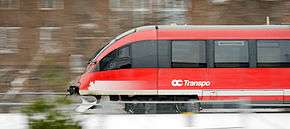 Train departing Bayview station | |||||||||||||||||||||||||||||||||||||||||||||||||||||||||||||||||||||||||||||||||||||||||||||||||||||||||||||||||||||||||||||||||||||||||||||||||||||||||||||||||||||||||||||||||||||||||||||||||||||||||||||||||||||||||||||||||||||||||||||||||||||||||||||||||||||||||||||||||||||||||||||||||||||||||||||||||||||||||||||||||||||||||||
| Overview | |||||||||||||||||||||||||||||||||||||||||||||||||||||||||||||||||||||||||||||||||||||||||||||||||||||||||||||||||||||||||||||||||||||||||||||||||||||||||||||||||||||||||||||||||||||||||||||||||||||||||||||||||||||||||||||||||||||||||||||||||||||||||||||||||||||||||||||||||||||||||||||||||||||||||||||||||||||||||||||||||||||||||||
| Type | Light rail | ||||||||||||||||||||||||||||||||||||||||||||||||||||||||||||||||||||||||||||||||||||||||||||||||||||||||||||||||||||||||||||||||||||||||||||||||||||||||||||||||||||||||||||||||||||||||||||||||||||||||||||||||||||||||||||||||||||||||||||||||||||||||||||||||||||||||||||||||||||||||||||||||||||||||||||||||||||||||||||||||||||||||||
| System | O-Train | ||||||||||||||||||||||||||||||||||||||||||||||||||||||||||||||||||||||||||||||||||||||||||||||||||||||||||||||||||||||||||||||||||||||||||||||||||||||||||||||||||||||||||||||||||||||||||||||||||||||||||||||||||||||||||||||||||||||||||||||||||||||||||||||||||||||||||||||||||||||||||||||||||||||||||||||||||||||||||||||||||||||||||
| Status | Closed for expansion | ||||||||||||||||||||||||||||||||||||||||||||||||||||||||||||||||||||||||||||||||||||||||||||||||||||||||||||||||||||||||||||||||||||||||||||||||||||||||||||||||||||||||||||||||||||||||||||||||||||||||||||||||||||||||||||||||||||||||||||||||||||||||||||||||||||||||||||||||||||||||||||||||||||||||||||||||||||||||||||||||||||||||||
| Locale | Ottawa, Ontario | ||||||||||||||||||||||||||||||||||||||||||||||||||||||||||||||||||||||||||||||||||||||||||||||||||||||||||||||||||||||||||||||||||||||||||||||||||||||||||||||||||||||||||||||||||||||||||||||||||||||||||||||||||||||||||||||||||||||||||||||||||||||||||||||||||||||||||||||||||||||||||||||||||||||||||||||||||||||||||||||||||||||||||
| Stations | 5 (+8 under construction) | ||||||||||||||||||||||||||||||||||||||||||||||||||||||||||||||||||||||||||||||||||||||||||||||||||||||||||||||||||||||||||||||||||||||||||||||||||||||||||||||||||||||||||||||||||||||||||||||||||||||||||||||||||||||||||||||||||||||||||||||||||||||||||||||||||||||||||||||||||||||||||||||||||||||||||||||||||||||||||||||||||||||||||
| Daily ridership | 20,000 (avg. weekday, Q4 2019)[1] | ||||||||||||||||||||||||||||||||||||||||||||||||||||||||||||||||||||||||||||||||||||||||||||||||||||||||||||||||||||||||||||||||||||||||||||||||||||||||||||||||||||||||||||||||||||||||||||||||||||||||||||||||||||||||||||||||||||||||||||||||||||||||||||||||||||||||||||||||||||||||||||||||||||||||||||||||||||||||||||||||||||||||||
| Ridership | 3,922,500 (2018)[2] | ||||||||||||||||||||||||||||||||||||||||||||||||||||||||||||||||||||||||||||||||||||||||||||||||||||||||||||||||||||||||||||||||||||||||||||||||||||||||||||||||||||||||||||||||||||||||||||||||||||||||||||||||||||||||||||||||||||||||||||||||||||||||||||||||||||||||||||||||||||||||||||||||||||||||||||||||||||||||||||||||||||||||||
| Website | Trillium Line (Line 2) | ||||||||||||||||||||||||||||||||||||||||||||||||||||||||||||||||||||||||||||||||||||||||||||||||||||||||||||||||||||||||||||||||||||||||||||||||||||||||||||||||||||||||||||||||||||||||||||||||||||||||||||||||||||||||||||||||||||||||||||||||||||||||||||||||||||||||||||||||||||||||||||||||||||||||||||||||||||||||||||||||||||||||||
| Operation | |||||||||||||||||||||||||||||||||||||||||||||||||||||||||||||||||||||||||||||||||||||||||||||||||||||||||||||||||||||||||||||||||||||||||||||||||||||||||||||||||||||||||||||||||||||||||||||||||||||||||||||||||||||||||||||||||||||||||||||||||||||||||||||||||||||||||||||||||||||||||||||||||||||||||||||||||||||||||||||||||||||||||||
| Opened | October 15, 2001 | ||||||||||||||||||||||||||||||||||||||||||||||||||||||||||||||||||||||||||||||||||||||||||||||||||||||||||||||||||||||||||||||||||||||||||||||||||||||||||||||||||||||||||||||||||||||||||||||||||||||||||||||||||||||||||||||||||||||||||||||||||||||||||||||||||||||||||||||||||||||||||||||||||||||||||||||||||||||||||||||||||||||||||
| Owner | City of Ottawa | ||||||||||||||||||||||||||||||||||||||||||||||||||||||||||||||||||||||||||||||||||||||||||||||||||||||||||||||||||||||||||||||||||||||||||||||||||||||||||||||||||||||||||||||||||||||||||||||||||||||||||||||||||||||||||||||||||||||||||||||||||||||||||||||||||||||||||||||||||||||||||||||||||||||||||||||||||||||||||||||||||||||||||
| Operator(s) | OC Transpo under the name Capital Railway | ||||||||||||||||||||||||||||||||||||||||||||||||||||||||||||||||||||||||||||||||||||||||||||||||||||||||||||||||||||||||||||||||||||||||||||||||||||||||||||||||||||||||||||||||||||||||||||||||||||||||||||||||||||||||||||||||||||||||||||||||||||||||||||||||||||||||||||||||||||||||||||||||||||||||||||||||||||||||||||||||||||||||||
| Rolling stock | |||||||||||||||||||||||||||||||||||||||||||||||||||||||||||||||||||||||||||||||||||||||||||||||||||||||||||||||||||||||||||||||||||||||||||||||||||||||||||||||||||||||||||||||||||||||||||||||||||||||||||||||||||||||||||||||||||||||||||||||||||||||||||||||||||||||||||||||||||||||||||||||||||||||||||||||||||||||||||||||||||||||||||
| Technical | |||||||||||||||||||||||||||||||||||||||||||||||||||||||||||||||||||||||||||||||||||||||||||||||||||||||||||||||||||||||||||||||||||||||||||||||||||||||||||||||||||||||||||||||||||||||||||||||||||||||||||||||||||||||||||||||||||||||||||||||||||||||||||||||||||||||||||||||||||||||||||||||||||||||||||||||||||||||||||||||||||||||||||
| Line length | 8 km (5 mi) | ||||||||||||||||||||||||||||||||||||||||||||||||||||||||||||||||||||||||||||||||||||||||||||||||||||||||||||||||||||||||||||||||||||||||||||||||||||||||||||||||||||||||||||||||||||||||||||||||||||||||||||||||||||||||||||||||||||||||||||||||||||||||||||||||||||||||||||||||||||||||||||||||||||||||||||||||||||||||||||||||||||||||||
| Track gauge | 1,435 mm (4 ft 8 1⁄2 in) standard gauge | ||||||||||||||||||||||||||||||||||||||||||||||||||||||||||||||||||||||||||||||||||||||||||||||||||||||||||||||||||||||||||||||||||||||||||||||||||||||||||||||||||||||||||||||||||||||||||||||||||||||||||||||||||||||||||||||||||||||||||||||||||||||||||||||||||||||||||||||||||||||||||||||||||||||||||||||||||||||||||||||||||||||||||
| Electrification | None | ||||||||||||||||||||||||||||||||||||||||||||||||||||||||||||||||||||||||||||||||||||||||||||||||||||||||||||||||||||||||||||||||||||||||||||||||||||||||||||||||||||||||||||||||||||||||||||||||||||||||||||||||||||||||||||||||||||||||||||||||||||||||||||||||||||||||||||||||||||||||||||||||||||||||||||||||||||||||||||||||||||||||||
| Signalling | |||||||||||||||||||||||||||||||||||||||||||||||||||||||||||||||||||||||||||||||||||||||||||||||||||||||||||||||||||||||||||||||||||||||||||||||||||||||||||||||||||||||||||||||||||||||||||||||||||||||||||||||||||||||||||||||||||||||||||||||||||||||||||||||||||||||||||||||||||||||||||||||||||||||||||||||||||||||||||||||||||||||||||
| |||||||||||||||||||||||||||||||||||||||||||||||||||||||||||||||||||||||||||||||||||||||||||||||||||||||||||||||||||||||||||||||||||||||||||||||||||||||||||||||||||||||||||||||||||||||||||||||||||||||||||||||||||||||||||||||||||||||||||||||||||||||||||||||||||||||||||||||||||||||||||||||||||||||||||||||||||||||||||||||||||||||||||
 | |
| Overview | |
|---|---|
| Headquarters | Walkley Yard |
| Reporting mark | CR |
| Locale | Ontario and Quebec |
From 2001 until 2020, the line ran north–south on a railway line, from Bayview to Greenboro, a distance of approximately 8 kilometres (5 mi). It is isolated from road traffic, but shares tracks with other trains; after operating hours, the section of track south of Walkley Yard has been infrequently used by Ottawa Central for freight service to the National Research Council.
Between 2013 and 2015, there was an upgrade of the line, including the complete replacement of the train fleet, in order to cut wait times during peak periods from 15 minutes to 12 minutes and eventually to 8–10 minutes. The upgrade was a precursor to extending the line southwards by four stations.[7]
In 2022, a 16-kilometre (9.9 mi) extension and upgrade to the existing line is expected to be completed, adding eight new stations and a connection to the Macdonald–Cartier International Airport.[8]
Service
Until 2020, the Trillium Line operated on a single-track rail line with five stations and three passing loops. With the exception of Carleton, all stations have only a single platform.
It is legally considered a federally-regulated mainline railway despite being used for local public transport purposes, and the service it provides is, in terms of its route and service frequency, more like that of an urban railway than a metro or tramway. The line is operated by the City of Ottawa under the official name "Capital Railway", which appears on the trains along with their regular logo.[9]
History
Pilot project
The Trillium Line was introduced on October 15, 2001, as a pilot project to provide an alternative to the Transitway bus rapid transit on which Ottawa had long depended exclusively for its high-grade transit service. The single-track line operated with five stations and a single passing loop at Carleton station.
As a pilot project, the Trillium Line system was built at the cost of CA$21 million, relatively little compared with the hundreds of millions of dollars usually required to build a new transit line. It runs on an existing Canadian Pacific Railway track (Ellwood and Prescott subdivisions[10]), so the only construction work necessary was to build the stations themselves and the passing tracks necessary to allow trains to operate in both directions.
From 2001 until 2015,[11] the system used three diesel-powered Bombardier Talent BR643 low-floor diesel multiple unit trains. It was, however, described as "light rail", partly because plans called for it to be extended into Ottawa’s downtown as a tramway-like service, and partly because the Talent vehicles, though designed for mainline railways in Europe, are much smaller and lighter than most mainline trains in North America, and do not meet the Association of American Railroads' standards for crash strength. Ottawa is also authorized to run trains with only a single operator and no other crew, something rare on mainline railways in North America.
Until late 2014, the official name of the diesel-powered, north–south line was "O-Train". After construction started on a second, east–west light rail line (the Confederation Line), the O-Train name was applied to the entire system, and the north–south line was renamed the "Trillium Line".[12]
Original service
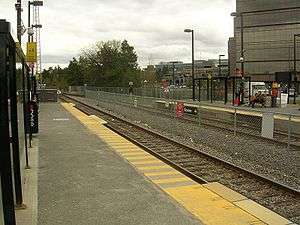
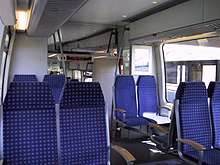
Ticketing on the Trillium Line originally worked entirely on a proof-of-payment basis; there were no ticket barriers or turnstiles, and the driver did not check fares. Occasionally, OC Transpo Special Constables or other employees prompted passengers for proof-of-payment. Tickets can be purchased from a vending machine on the platform, and certain bus passes are also valid for the Trillium Line. Trillium Line tickets were exchanged for bus transfers upon boarding a bus. Although bus transfers can be used to board the O-Train, prepaid bus tickets cannot.
The European trains are narrower than the North American standard. In order to enable night-time use of the line by standard-width freight services, retractable platform extenders are mounted at each station (other than Bayview which is constructed on its own private rail spur). Passengers gain access to the Trillium Line on these extenders. If the line is used for freight, the extenders are retracted allowing a wider train to pass through the station. The extender interface with the train has been refined over time, and cyclists and wheelchair users now have no trouble accessing the train.
The service frequency of a train every fifteen minutes made it possible to run the line with a fleet of just three trains (of which only two were in service at any given time) and a single track, apart from passing sidings at Carleton station.
The Trillium Line hit the 1-millionth rider mark on May 29, 2002, the 5-millionth mark on January 21, 2005, and the 10-millionth in late 2010.[13] In mid-2011, the Trillium Line carried an average of approximately 12,000 riders each day.[14]
Awards
In June 2002, the O-Train Light Rail Transit project received the Canadian Urban Transit Association’s Corporate Innovation Award.[15]
On January 16, 2003, the Ontario chapter of the American Public Works Association (APWA) presented the City of Ottawa, Canadian Pacific Railway and Morrison Hershfield with the APWA Public Works Project of the Year award in the transportation category. This award was established to highlight excellence in the management and administration of public works projects by recognizing the alliance between the managing agency, the consultant and the contractors who, working together, complete public works projects.[16]
A third award the Trillium Line light rail transit project received was in May 2003, in the sustainable transportation category of the FCM-CH2M Hill Sustainable Community Awards.[15]
Criticism of pilot project
The main complaints about the Trillium Line pilot have revolved around its placement and ridership levels. The Trillium Line's route was determined by existing railway tracks, rather than the parts of the city that needed public transport, which would have required new tracks to be laid. Carleton University students, however, benefited from the Trillium Line pilot project, as it connected the university to the busy Ottawa Transitway system.
The other criticism is that there is very low ridership of the trains compared to some very crowded bus lines such as the 90–99 series routes. One fully loaded Trillium Line train carries 285 passengers compared to 131 passengers for an articulated bus.[17] The O-Train schedule is limited by track capacity.
Early extension plans
In July 2006, Ottawa City Council approved a north–south light rail expansion project. The project would have terminated diesel light rail service on the Trillium Line so as to reuse its right-of-way for a double-track, electric light rail line that would have extended west from the University of Ottawa to Bayview then south to Leitrim and then west to Barrhaven. However, in December 2006, Ottawa City Council cancelled this project, thus leaving the diesel-powered Trillium Line unchanged.
Service improvements
On May 18, 2011, OC Transpo approved a $200,000 study to expand the Trillium Line. The $59-million proposal included the purchase of six new trainsets and track improvements that would increase headways to eight minutes from fifteen.[14] The project would finally cost $60.3 million.[7]
In mid-2013, service on the Trillium Line was suspended for four months to implement service and track improvements such as new station platforms and two new passing tracks (near Brookfield and Gladstone).[7][18] Upgrades were also made to the signal system, train controls, stations, tracks and train yard. A new centralized traffic control system was installed to improve safety and efficiency.[7] Six new Alstom Coradia LINT trainsets (replacing the three older Bombardier Talent units) and the two extra passing loops allowed the number of trains on the line to double to four.
Expanded service began on March 2, 2015, but suffered numerous problems during the first week.[11] Although the changes were intended to improve frequency to eight minutes, the Trillium Line would ultimately operate at twelve minute frequency.[19] After the completion of the Stage 2 project, the line was originally planned to continue operating using single-car trains; however, because of the lower-than-intended frequency, the city was forced to adjust the Stage 2 plan to include longer trains and platforms to compensate.[20]
Derailment
On August 11, 2014, train C3 derailed while traveling northbound over the switch just south of Carleton Station.[21] The cause was determined to be a faulty spring switch that had not closed properly as well as the operator failing to follow regulations and physically inspect the switch after spotting a signal irregularity. No serious injuries occurred as a result of the derailment, however train C3 received damage and was taken out of service. C3 was never repaired and never returned to service[22] and as a result the line continued to operate with only two operational trains until the following March when the new Alstom LINT trains entered service. In June 2017, the spring switches at Carleton were replaced with powered switches.[23]
Stage 2 expansion
_(cropped).jpg)
As part of the city's Stage 2 LRT project, the Trillium Line will be extended 16 kilometres (9.9 mi) in the south, including a 3-kilometre (1.9 mi) branch to Macdonald–Cartier International Airport and the EY Centre, with four new stations at South Keys, Leitrim, Bowesville and Limebank in Riverside South. There will be a new passing loop at South Keys station and the track will be fully doubled from the Leitrim Road overpass to Limebank station. The full extension will be grade separated. In addition, two more stations will be built along the existing portion of the line at Gladstone and Walkley.[24] The project will also include a number of other significant upgrades including the lengthening of all existing passing loops, the purchase of seven new trains, the doubling in length of all existing platforms, the grade separation of the Ellwood diamond to allow Via trains to cross underneath the Trillium Line, the rehabilitation of rail bridges over the Rideau River and of the Dow's Lake rail tunnel, the upgrading of the signalling system to allow the implementation of positive train control, the construction of several new pedestrian tunnels and overpasses, and numerous guideway and vehicle rehabilitation projects.[25] The contract for this project was approved on March 7, 2019, by city council,[26] with construction of the airport spur beginning in mid-2019. The project is expected to be completed by the fourth quarter of 2022.
The 3-kilometre (1.9 mi) airport link will run from Macdonald–Cartier International Airport north to South Keys station, where riders will need to change trains to continue to Bayview station. South Keys station will feature an island platform to facilitate cross-platform transfers for passengers arriving from the airport branch to trains bound for Bayview station. The city is not contributing any money to this spur, with the funding instead coming from the federal and provincial governments, as well as the airport authority.[27]
On February 22, 2019, the city announced that the selected proponent to construct the project was TransitNEXT, a wholly owned subsidiary of SNC-Lavalin.[28][29] This decision was controversial as the federal government and SNC-Lavalin were involved in a political scandal at the time, which led to extra scrutiny by city councillors, with some calling for a delay on the vote to approve the contract in order to allow more time for review. Ultimately Council voted not to delay the approval and the contract was approved on March 7, 2019.[26] It was later revealed that TransitNEXT's bid had not met the minimum technical scoring threshold in order to be considered, which continued the controversy.[30] The city eventually explained that the decision to award the contract to TransitNEXT was done at the discretion of city staff to get a better deal for the city and was within the rules of the procurement process.[31] An investigation conducted by the city's auditor general later confirmed that the authority delegated by council gave city staff sole discretion on whether to allow a bid to proceed even if it had not met the minimum scoring threshold, and that staff had otherwise correctly followed the entire procurement process that had been approved by council.[32]
Work on the Stage 2 extension began in mid-2019, starting with the clear-cutting of trees along the corridors that will be used by the extension. Construction of the airport spur is expected to be completed in 2020 to give the airport authority time to rebuild the terminal and connect it to the future station.[33][34]
Further extensions
Extending the Trillium Line across the Ottawa River into Gatineau across the Prince of Wales Bridge had been proposed as early as the original pilot project proposal. The city's certificate of fitness for the Trillium Line, issued by the Canadian Transportation Authority in 2001, indicates that it operates between the provinces of Ontario and Quebec, despite the line never having actually operated across the river.[35] The city even considered converting the rail bridge into a pedestrian crossing at one point.[36] When the city announced the contract awards for Stage 2, it also presented a map of the O-Train network that included proposed extensions that would be a part of a Stage 3 phase, including extensions to Kanata, Barrhaven, and Gatineau.[37] On September 24, 2019, the cities of Ottawa and Gatineau jointly announced that they no longer intended to use the Prince of Wales bridge for any kind of rail connection, citing capacity concerns at Bayview station.[38] Despite the announcement, the future of the bridge remains uncertain since city staff later indicated that the bridge is still in the city's long term transit plans, though it could be converted for use as a pedestrian bridge in the interim. More on the future of the bridge as a rail link will be announced in the second quarter of 2020 when the city of Gatineau will present the results of a long-term transit study.[39]
Stations
As of 2019, ticket barriers are installed and operational in all Line 2 stations. They were initially installed in all stations except for Bayview in order to test the hardware and software of the fare gate system before it was installed in all thirteen stations on the Line 1 Confederation Line.
The Trillium Line stations have large, bus-style sheltered waiting areas for passengers. All stations have level boarding platforms to allow for wheelchair access and easier boarding for all passengers. Elevators are available at Greenboro (for Transitway riders), Carling (for Line 2 riders) and Bayview (for train transfers within the fare-paid zone).
| Station | Notes |
|---|---|
| Bayview | The northbound terminus for the Trillium Line, this station provides an interchange with the Confederation Line (Line 1) in a fare-paid zone and access to the Transitway nearby on Wellington Street. Two public washrooms are located in the Trillium Line waiting area.[40] The station is located on a stub-end track branching off from the railway line, immediately under the Transitway overpass. It is the closest Trillium Line station to downtown Ottawa. |
| Gladstone | Originally planned to be part of the pilot project but was cut for budgetary reasons.[41] A passing loop was added in 2013 to increase train frequency and line capacity.[18] It is the site of a future station that will feature two platforms on a double track extending from approximately the Beech Street underpass all the way to the terminus at Bayview station.[24] |
| Carling | Located at Carling Avenue and Preston Street. South of Carling, the train enters a tunnel to pass under Dow's Lake. |
| Carleton | Serves Carleton University and has separate tracks and platforms for each direction. Until the upgrade of the line in 2013, this station had the only passing loop along the line. South of Carleton, the train crosses over the Rideau River on a bridge. |
| Mooney's Bay | Originally known as "Confederation" after the Confederation Heights area (Heron and Bronson intersection), the station was renamed on December 24, 2018, to avoid confusion with the Confederation Line.[42] It serves Government of Canada offices in the surrounding area, including Canada Post. |
| Walkley | Originally planned to be part of the pilot project but was cut for budgetary reasons.[41] A passing loop was added in 2013 just north of Walkley to increase train frequency and line capacity.[18] It is the site of a future station immediately south of Walkley Road and near the existing Transitway station.[24] |
| Greenboro | Provides an interchange with a large Transitway station, which has a large park-and-ride lot and is located next to the South Keys Shopping Centre. The Trillium Line platform is level with the pedestrian overpass crossing the Transitway. |
| South Keys | Future connection between the main portion of Line 2 and the airport rail link. It will be a centre-platform station in the middle of a double-tracked segment and include a pocket track just north of the station for storing a trainset on layup. The rail link trains are projected to arrive and depart in sync with the Line 2 trains. |
| Leitrim | Adjacent to the existing station and park-and-ride lot. This station will feature two platforms and an expanded park-and-ride lot. |
| Bowesville | Located just east of Bowesville Road. This station will feature two platforms and will be the site of a new park-and-ride lot. |
| Limebank | The southbound terminus for the Trillium Line, it will be located just west of Limebank Road and south of Earl Armstrong Road. This station will serve the Riverside South community within an expansive area zoned for commercial and retail purposes. As with the Bayview terminus station, it will feature a public washroom. |
| Station | Notes |
|---|---|
| South Keys | The northbound terminus for the Airport Link, this station provides an interchange with the Trillium Line (Line 2) in a fare-paid zone, and access to the Transitway nearby. |
| Uplands | Will be built East of Uplands Drive next to the EY Centre and will feature two platforms. It will be the location of the only passing loop on the spur. |
| Airport | The southbound terminus for the Airport Link, it will be located at the Ottawa Macdonald–Cartier International Airport and built into the renovated terminal at the departures level. |
Fleet

The Trillium Line initially used three Bombardier Talent diesel multiple unit (DMU) trains for service. Each train (numbered C1–C3)[22] consisted of three cars, with the front and rear powered and the centre towed. The trains were originally ordered by Deutsche Bahn and later delivered to OC Transpo. After being retired in 2015, the units were put up for auction multiple times[43] before eventually being sold for C$25,200 on December 14, 2018.[22]
In September 2011, Alstom announced that it would deliver six new two-car Coradia LINT train sets in 2013;[44] the trains were handed over to OC Transpo in June 2013.[45] These trains were put into service on March 2, 2015, and the Bombardier Talent units were subsequently retired.[46]
On May 3, 2018, it was announced that the city would be purchasing seven new Stadler FLIRT trains to use on the extended Trillium Line after the completion of Stage 2.[47] These trains will be approximately 80 metres (262 ft) long, which is double the 41-metre (135 ft) length of the current Coradia LINT trains. The new trains will operate alongside coupled pairs of the existing LINT trains on the main line as part of a mixed fleet. These vehicles will be manufactured in Switzerland before being transported to Canada for final assembly.[48] The trains will have a diesel-electric drive with the possibility of future electrification.
| Class | Image | Type | Number of doors | Top speed | Number | Built | Years of service |
|---|---|---|---|---|---|---|---|
| Bombardier Talent BR643 | 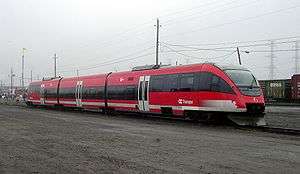 |
DMU | 3 per side | 100 km/h (62 mph) | 3 three-car sets (9 cars total) |
1999 | Trillium Line (2001–2015) |
| Alstom Coradia LINT 41 | 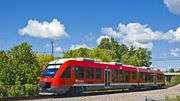 |
DMU | 2 per side | 140 km/h (87 mph) | 6 two-car pairs (12 cars total) |
2013 | Trillium Line (2015–) Airport Link (2022–) |
| Stadler FLIRT3 | DEMU | 8 per side | 130 km/h (81 mph)[49] | 7 four-car sets (28 cars total, not including power packs) |
TBD | Trillium Line (2022–) |
Facilities
Train sets are stored at the Walkley Yard located northeast of the Greenboro station. Before their retirement, the Bombardier Talent trainsets were maintained by Bombardier Transportation at the Walkley facilities. Bombardier continues to perform maintenance of the Trillium Line fleet, which included standstill maintenance of the retired Bombardier Talent trains until March 8, 2018.[50] The Walkley Yard was built in 1955 by the National Capital Commission for the Canadian National Railways and later sold to the Canadian Pacific Railway. The yard has enclosed buildings for repairs and outdoor storage tracks.
As part of the Stage 2 project, a new maintenance facility will be built adjacent and to the west of the existing facilities.[51] The construction of the new yard facilities began in 2019.[52]
See also
References
- Manconi, John (General Manager, Transportation Services) (January 23, 2020). Special Transit Commission meeting - January 23, 2020 (Audio Recording). 14 minutes in. Retrieved May 6, 2020.
Ridership on the Trillium Line set new all-time records in September, October, November, and December, and on an average weekday we carry approximately 20,000 passenger trips on that line.
- "Public Transportation Ridership: Fourth Quarter 2018" (PDF). American Public Transit Association. Retrieved May 4, 2020.
- "O-Train Line 2 | OC Transpo". www.octranspo.com. Retrieved July 15, 2020.
- Ramlakhan, Krystalle (February 24, 2019). "Students rail against longer-than-expected O-Train shutdown". CBC News. Archived from the original on September 30, 2019. Retrieved October 28, 2019.
- "Here's what's happening for Stage 2 LRT construction right now". October 24, 2019. Archived from the original on October 28, 2019. Retrieved October 28, 2019.
- "Trillium Line shuts down for next 2 years". CBC News. May 3, 2020. Retrieved May 3, 2020.
- "New Trains improve O-Train Trillium Line service". City of Ottawa. March 2, 2015. Retrieved July 31, 2015.
- "Trillium Line South". Stage 2 Ottawa. Archived from the original on November 9, 2019. Retrieved November 8, 2019.
- "Decision No. 283-R-2007". www.otc-cta.gc.ca. June 6, 2007. Archived from the original on April 5, 2019. Retrieved March 10, 2019.
- Duncan, Paul. "Ottawa Railways" (GIF). NiagaraRails.com. Retrieved January 12, 2009.
- "O-Train shut down day after launch of expanded line (with video)". The Ottawa Citizen. March 3, 2015. Archived from the original on February 9, 2019. Retrieved July 29, 2015.
- "O-Train name approved for Ottawa light rail system". CBC News Network. September 17, 2014. Archived from the original on October 7, 2014. Retrieved December 29, 2014.
- "OC Transpo - Odometer passes 1 Millionth KM!". octranspo.com. Archived from the original on January 19, 2019. Retrieved August 7, 2010.
- "Ottawa O-Train extension proposed". Railway Gazette International. May 24, 2011. Archived from the original on May 28, 2011. Retrieved May 28, 2011.
- "O-Train Light Rail Project". Archived from the original on January 23, 2011. Retrieved April 5, 2011.
- "Acec.ca". Archived from the original on July 24, 2011. Retrieved April 5, 2011.
- "OC Transpo adds new low-floor articulated buses to its fleet". OC Transpo. April 5, 2001. Archived from the original on September 29, 2007. Retrieved January 12, 2009.
- Hua, John (September 3, 2013). "Ottawa's O-Train back on track". CTVNews.ca. Bell Media. Archived from the original on September 6, 2013. Retrieved July 29, 2015.
- "Line 2 O-Train schedule". octranspo.com. Retrieved February 8, 2019.
- "Appendix A Consultation Record" (PDF). May 19, 2015. p. 12. Retrieved May 3, 2020.
- Pearson, Matthew (August 22, 2014). "Human error, faulty switch caused O-Train derailment". Ottawa Citizen. Archived from the original on February 17, 2019. Retrieved February 16, 2019.
- "Lot of Three (3) 1999 Bombardier Talent Trainsets and Parts - govdeals.com". www.govdeals.com. Archived from the original on February 1, 2019. Retrieved January 31, 2019.
- shadqadri (June 9, 2017). "O-Train Service Adjustment – Carleton Spring Switch/Preventative Maintenance". Shad Qadri. Archived from the original on February 17, 2019. Retrieved February 16, 2019.
- "Stage 2 - Trillium Line South". City of Ottawa. 2015. Archived from the original on September 24, 2015. Retrieved August 1, 2015.
- "FAQs: Stage 2 LRT Contract Award" (PDF). p. 12. Archived (PDF) from the original on September 1, 2019. Retrieved September 1, 2019.
- "City council approves stage 2 of LRT". CTV News Ottawa. Archived from the original on September 1, 2019. Retrieved September 1, 2019.
- "Contract Award of Ottawa's Stage 2 Light Rail Transit Projects and Related Matters" (PDF). February 22, 2019. p. 10. Archived (PDF) from the original on September 1, 2019. Retrieved September 1, 2019.
- "Stage 2 Light Rail Transit Project" (PDF). February 22, 2019. Archived (PDF) from the original on September 1, 2019. Retrieved September 1, 2019.
- "TransitNEXT finalizes Contract for Trillium Line Extension Project". www.snclavalin.com. Retrieved September 1, 2019.
- Chianello, Joanne (March 22, 2019). "SNC-Lavalin failed to meet technical threshold for $1.6B LRT contract: sources". CBC. Archived from the original on August 15, 2019. Retrieved September 1, 2019.
- Willing, Jon (August 2, 2019). "City admits it let SNC-Lavalin through Stage 2 LRT bidding despite lower technical score". Ottawa Citizen. Archived from the original on August 4, 2019. Retrieved September 1, 2019.
- Willing, Jon (November 26, 2019). "City followed the rules in selecting SNC-Lavalin for LRT Stage 2 project, auditor general finds". Ottawa Citizen. Retrieved November 27, 2019.
- Crawford, Blair (November 14, 2019). "Construction of LRT Stage 2 leaving its mark on the city". Ottawa Citizen. Retrieved November 27, 2019.
- Toolkit, Web Experience (August 1, 2019). "Determination No. R-2019-73". otc-cta.gc.ca. Retrieved November 27, 2019.
- "Decision No. 635-R-2006". otc-cta.gc.ca. November 17, 2006. Archived from the original on September 1, 2019. Retrieved September 1, 2019.
- Steele, Alistair (February 2, 2015). "Ad to convert rail bridge over Ottawa River posted early, city says". CBC. Archived from the original on May 4, 2019. Retrieved September 1, 2019.
- "Stage 2 Light Rail Transit Project" (PDF). February 22, 2019. p. 109. Archived (PDF) from the original on September 1, 2019. Retrieved September 1, 2019.
- "Mayors rule out Prince of Wales Bridge for transit link". CBC. September 24, 2019. Archived from the original on September 25, 2019. Retrieved September 24, 2019.
- "Prince of Wales Bridge back on track as future rail link". Capital Current. Retrieved December 13, 2019.
- "Bayview". www.octranspo.com. Archived from the original on October 8, 2019. Retrieved October 8, 2019.
- "Light Rail Pilot Project: Recommended Service Concept and Cost Analysis" (PDF). Archived (PDF) from the original on February 1, 2019. Retrieved January 31, 2019.
- "New winter service starts on Dec. 24". OC Transpo.
- Willing, Jon (December 28, 2016). "City auctioning off Bombardier trains". Ottawa Citizen. Archived from the original on February 1, 2019. Retrieved February 9, 2019.
- "OC Transpo chooses Alstom to supply six new commuter trains to Ottawa". Alstom. September 16, 2011. Archived from the original on November 17, 2012. Retrieved July 6, 2012.
- "In Ottawa, Alstom introduces first European-style commuter trains for North America". Alstom. June 25, 2013. Archived from the original on August 16, 2013. Retrieved July 6, 2013.
- "Archived copy". Archived from the original on March 27, 2019. Retrieved January 27, 2019.CS1 maint: archived copy as title (link)
- "City secures funding to extend O-Train Trillium Line to the heart of Riverside South". stage2lrt.ca. May 10, 2018. Archived from the original on August 15, 2019. Retrieved August 15, 2019.
- Report to: Council (PDF) (Technical report). February 22, 2019. p. 52. Archived (PDF) from the original on February 26, 2019. Retrieved February 26, 2019.
- "Appendix C – Trillium Line EA Addendum Supplementary Terrestrial Information (Ellwood Diamond, Walkley Yard, Bowesville and Limebank) Air Quality Report" (PDF). Archived (PDF) from the original on September 18, 2018. Retrieved September 18, 2018.
- "Lot of Three (3) 1999 Bombardier Talent Trainsets and Parts - govdeals.com". www.govdeals.com. Archived from the original on February 1, 2019. Retrieved February 9, 2019.
- "Relocated Walkley Yard MSF, West of Albion Road" (PDF). January 17, 2016. Archived (PDF) from the original on February 23, 2019. Retrieved February 22, 2019.
- "Transit Services 2020 Business Plan". ottwatch.ca. February 19, 2019. p. 12. Retrieved February 23, 2020.
External links
![]()
- OC Transpo – O-Train Line 2 Trillium Line (official site)
- City of Ottawa - LRT Stage 2 - Trillium Line South Extension including map and station renderings
- 2002 O-Train Evaluation Report
- Transport Canada O-Train Light Rail Project Summary circa 2010 (Internet Archive)
- O-Train construction pictures
- Salient Features of the O-Train (Trillium) Route Between Bayview and Greenboro as of August 2017

